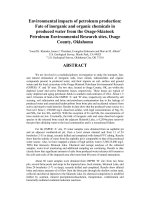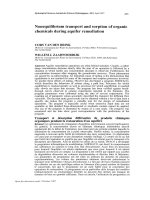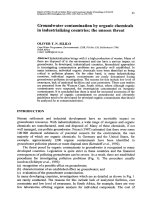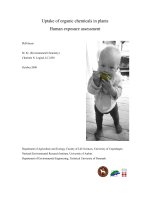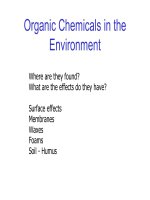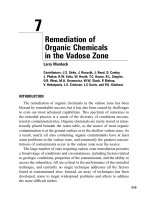Transport and fate of persistent toxic organic chemicals in aquatic ecosystems: the Niagara River to St Lawrence River Estuary example pptx
Bạn đang xem bản rút gọn của tài liệu. Xem và tải ngay bản đầy đủ của tài liệu tại đây (844.02 KB, 12 trang )
Hydrolôgical,
Chemical
and
Biological
Processes
of
Transformation
and
Transport
of
Contaminants
in
Aquatic
Environments
(Proceedings of the Rostov-on-Don Symposium, May 1993). IAHS Publ. no. 219, 1994. 21
Transport and fate of persistent toxic organic chemicals
in aquatic ecosystems: the Niagara River to
St Lawrence River Estuary example
R. J. ALLAN
National Water
Research
Institute, Canada Centre for Inland Waters, Burlington,
Ontario
V7R 4A6, Canada
Abstract The transport and fate of persistent toxic organic chemicals
in fresh-water ecosystems are controlled by many properties of the
aquatic ecosystems themselves and of the specific chemicals.
Predictions of the fate of specific chemicals can, to some extent, be
modelled from chemical properties and laboratory tests, but in real
aquatic ecosystems, accurate predictions of eventual sinks, trends and
concentrations in biota and response to remedial measures are site
specific. This paper discusses the media involved in the aquatic
transport of persistent toxic organic chemicals and the role of aquatic
ecosystem media in the eventual fate of the chemicals. Specific
examples are drawn from the last decade of research on the Niagara
River to the St Lawrence River Estuary system.
INTRODUCTION
Detection of persistent toxic organic chemical (PTOC) contamination in the Great Lakes
began
in the
early 1960s with pesticides such as DDT and dieldrin, followed in the 1970s
by other organochlorine pesticides and industrial organic chemicals such as PCBs. The
insecticide mirex was then discovered in 1974 in fish in the Bay of
Quinte;
chlorinated
dioxiris were detected in herring gull eggs from colonies in Saginaw Bay in 1979; and
toxaphene was detected in fish from Lake Superior in 1982. Subsequent sampling has
shown that many of these PTOCs can be detected in various media throughout the entire
Great Lakes-St Lawrence River ecosystem. The available information on PTOC
contamination of the Niagara River to St Lawrence Estuary system although far from
complete, may be greater than exists for any other fresh-water system in the world.
Recently, a special volume of the journal
Science
of the Total
Environment
(Allan
et
al.,
1990) contained several papers on the transport and fate of toxic chemicals in the
St Lawrence River and Estuary and a major review was completed on Toxic Chemicals
in the Great Lakes and Associated Effects (Allan et al., 1991). The special volume and
review together encompass much of the research and monitoring results on transport and
fate of
toxic
chemicals in this major river-lake estuary ecosystem.
TRANSPORT OF PERSISTENT TOXIC ORGANIC CHEMICALS
The waterways of the Niagara River to the St Lawrence River Estuary system (Fig. 1)
22
R.
J. Allan
PTOC = PERSISTENT TOXIC
ORGANIC CHEMICAL
BOTTOM SEDIMENT
CORE LOCATIONS
URBAN AREAS
QUEBEC
/ NORÎH
- / ATLANTIC
-/ OCEAN
ONTARIO
PTOC
TEMPORARY
STORAGE
TORONTO
PTOC
BURIAU
ACCUMULATION
NEW YORK
0 50 100km
Fig. 1 Schematic of the main components of the Niagara River to St Lawrence River
Estuary system and their primary role in PTOC transport and fate.
are made up of four types of units. The first comprises the high discharge (6000-
13 000 m
3
s"
1
), rapid flow rivers, namely the Niagara and St Lawrence. Second are
the shallow, short residence time (days to weeks), riverine lakes, namely St Francois,
St Louis and St Pierre. Third is the deep, long residence time (10 years), Lake
Ontario. Lastly, there is the fresh-water/salt-water St Lawrence Estuary.
The rivers are essentially PTOC transport systems on a grand scale. The riverine
lakes provide only temporary storage or sinks even for contaminants associated with
sediments because these are eventually resuspended and moved on downstream. The
major sinks where long-term effects become evident are Lake Ontario and the
St Lawrence Estuary. These sites are also where sediment associated contaminants can
be permanently removed by deep burial in bottom sediments. Even so, some of the
PTOCs transported still pass out of the system to the Gulf of St Lawrence and beyond.
Water (dissolved) and sediment (particulate-bound) analyses are a requirement to
determine the transport media of PTOCs. However, reliable, quantitative data for
dissolved PTOCs are still scarce. For the last decade, large volumes of water (200 up
to 1000 1) have been extracted to detect these dissolved concentrations in the low ppt
and ppq ranges and often continuous extraction systems are now employed. The
presently detected dissolved concentrations of PTOCs in water are often an order of
magnitude or more beneath former detection limits. Concentrations of PTOCs in whole
water, and especially for the dissolved phase, can be highly variable in space and time
and must still be viewed with caution because they are often still near our limits of
analytical detection. Alternatively, most concentrations for PTOCs in suspended
particulates and bottom sediments are considered reliable. Sectioned, radiodated lake
Transport and fate of persistent toxic chemicals in aquatic ecosystems 23
bottom sediment cores have been of great value in revealing long-term historical trends
in inputs of PTOCs to the system.
Example 1 - PCBs transport
The Niagara River has a discharge of some 6000 m
3
s"
1
into Lake Ontario.
Concentrations of "dissolved" (the fraction not removed by high speed centrifugation)
PTOCs are in the ppt or ppq range. However, the total load transported into Lake
Ontario
can
be considerable given the high discharge. Chemicals such as lindane which
have low partitioning coefficients are transported primarily in the dissolved phase.
Although toxic organic chemicals with high partitioning coefficients such as the higher
chlorinated PCBs are concentrated in the suspended solids phase (ppb range), much
of the load of such chemicals is still transported in the operationally defined dissolved
phase because of the low suspended solids concentrations in the Niagara River (1 to
10 mg r
1
) (McCrea et al, 1985).
The
St
Lawrence River drains the Great Lakes to the Atlantic Ocean. At its source
in Lake Ontario, the flow is some 7700 m
3
s"
1
and rises to 12 700 m
3
s"
1
at its mouth
at Quebec City. A given water mass traverses the river in five to seven days.
Concentrations of suspended solids rise from some
1
mg l"
1
at the river source to some
10 mg
l"
1
at Quebec City, at the upper end of the St Lawrence Estuary. Water samples
have been collected between Lake Ontario and the estuary and processed by high speed
centrifuge followed by large volume extraction of the effluent to determine changes
in the fraction of the PTOC load transported in the operationally defined particulate
and dissolved phases (Kaiser et al., 1990). PCB concentrations in the suspended solids
decreased downstream from around 1000 ppb to 200 ppb. However, because there is
a ten times increase in suspended solids, the PCB load is actually doubled due to input
from various sources along the river. A further refinement of the particulate versus
dissolved split was the removal from the high speed centrifuge effluent of the colloids
normally incorporated into the operationally defined dissolved phase (Comba et al.,
1990).
The
concentration of PCBs in these super centrifuged fine particles (Fig. 2) was
one to two orders of magnitude higher than in the particulates normally extracted by
only high speed centrifuges. The PCBs introduced to the river at its source are mainly
in the dissolved phase as are those introduced along its course but they generally
become more fractionated into or onto the particulate phase during passage
downstream.
Example 2 - mirex transport
The insecticide and flame retardant, mirex, was first discovered at the eastern end of
Lake Ontario (Kaiser, 1974). The main input of the chemical to Lake Ontario was
from a source along the Niagara River. By the late 1980s, extension of sampling
programs down the St Lawrence had revealed that this PTOC had been transported in
the water column as far as the St Lawrence Estuary and beyond. Although the
concentration of mirex in suspended particulates declines downstream, the chemical
was still detectable some 1000 km downstream of the major site near Niagara Falls of
its original introduction to this river-lake estuary system. The concentrations of mirex
24
R.
J. Allan
TOTAL PCB FLUX IN WATER
COLUMN ["dissolved" phase;
TOTAL PCB ON SUSPENDED
PARTICULATES (Westfalia;
TOTAL PCB FLUX ON
RECAPTURED PARTICLES
(Sorval) IN DISSOLVED
PHASE
ONTARIO
KINGSTON
N
577
3
4:39
UPPER
ST.
LAWRENCE RIVER
ESTUARY
679
174:~
;:416
LAKE
ONTARIO
NEW YORK
Fig. 2 Particulate, "dissolved" and colloidal PCB transport in the St Lawrence River
(adapted from Comba et al., 1990).
in suspended solids at the source of the St Lawrence are around 5 ppb and decrease
to some 1 ppb near Quebec City which translates to a flux of some 1 to 2 kg of
mirex/year. Most recently, Kaiser et al. (1990) used improved extraction procedures
to detect mirex in the operationally dissolved phase at many sites down the river. The
highest value was 13 pp quadrillion. The dispersal of
this
highly hydrophobic chemical
from the Niagara River to the St Lawrence Estuary is clear evidence of the long-range
aquatic dispersion of PTOCs on a scale which only now can be quantified. Further
evidence of this long-range aquatic transport comes from comparison of the mirex
distribution in bottom sediment cores from Lake Ontario and the Laurentian Trough
in the lower St Lawrence Estuary (Figs 1 and 3).
FATE OF PERSISTENT TOXIC ORGANIC CHEMICALS
The fate of PTOCs in aquatic ecosystems is complex and involves many processes
including dilution, sorbtion/desorbtion, volatilization, burial and degradation by
chemical and biological processes. The fate of PTOCs in the system is not only
governed by the physicochemical characteristics of the chemicals, i.e., solubility,
volatility, hydrophobicity, degree of partitioning (into or onto sediment and other
particulates), lipophilicity, and resistance to degradation (by hydrolytic, photochemical,
and biochemical routes) but also by factors and by processes related to the
characteristics of the receiving water bodies, namely suspended particulate
concentrations and type, sedimentation rates, trophic level, and food webs.
Transport and fate of persistent toxic chemicals
in
aquatic ecosystems
25
•5?
Q.
z
LU
o
z
o
o
X
LU
en
0.2-
0.1 -
0 -
LAURENTIAN TROUGH
PEAKCONC. 0.19 ppb, 1981
r*w^"i
_
•
• i
1
~J~T_,
1950
1960 1970 1980 1990
? 70
jZ 60
<
DC
50
40 -
30 -i
20 -
10
m
B
LAKE ONTARIO
ROCHESTER BASIN
PEAK CONC.
65 ppb, 1967
(Approx. 340 x
max. cone.
in trough)
i,
r
LAUR.
TROUGH
MAX.
1950 1990
1960 1970 1980
YEAR OF DEPOSITION
Fig.
3
Comparison
of
mirex profiles
in
bottom sediment cores from Lake Ontario
and
the Laurentian Trough (adapted from Oliver
et al., 1989 and
Comba
et al.,
1992).
In large lakes such
as
Lake Ontario, three critical limnological factors which
interact
to
affect
the
fate
of
PTOCs
are (1)
suspended particulate concentrations,
(2) water residence time;
and (3)
trophic state, which
are
interlinked
in
complex
and
site specific ways.
For
example,
a
high inorganic sediment load combined with
a
high
trophic state could lead
to
high sediment-water partitioning, followed
by
rapid
sedimentation
and
burial
of
PTOCs. The critical processes which control
the
fate
of
PTOCs in water bodies
are
those which operate across
the
major interfaces between
main ecosystem components
of air,
water, sediment,
and
biotic material. Better
quantification
of the
role
of
these interfaces
on the
movement
of
PTOCs leads
to a
better ability
to
understand, model,
and
predict
the
aquatic fate
of
PTOCs.
The
following discussion focuses
on
these interfaces
as
they affect PTOC fate.
A
more
extensive discussion
is to be
found
in
Allan (1989a).
The role
of
the atmosphere
The air-water interface involves
the
atmosphere
as
both
a
source
of
PTOCs
and
waterways
as a
source
of
PTOCs
to the
atmosphere. Water bodies such
as
Lake
Ontario
and
the St Lawrence Estuary, have large surface areas which can translate into
26
R.
J. Allan
a large direct atmospheric input of PTOCs in vapour, wet and dry-fall-particulate
phases. For specific chemicals, there remains considerable debate as to the importance
of the atmospheric source relative to others because most of the data on atmospheric
loads of chemicals is derived from analyses of
only
wet precipitation, particularly rain,
for chemicals such as DDT, PCBs, toxaphene, and 7-BHC (Eisenreich et al., 1980).
Adequate samplers necessary to measure PTOC inputs in all wet, dry and gaseous
phases on a routine and event basis are only now being systematically deployed, even
in the Great Lakes Basin.
The release of chemicals from water bodies to the atmosphere is a process readily
accepted for those chemicals referred to as volatiles. Such volatiles are rapidly lost to
the atmosphere, except in ice-covered areas during winter months. The fact that there
are always measurable concentrations of volatiles such as perchloroethylene in the
Niagara River to St Lawrence Estuary system, is because there are continuous
industrial and municipal inputs. Other less volatile PTOCs such as the lower
chlorinated PCBs and chlorinated benzenes are however also volatile and released into
the atmosphere. Their contribution to the atmosphere is usually determined by
difference in mass balance calculations. Using this approach, Oliver (1984a) concluded
that greater than 80% of several chlorinated benzenes, including HCB, introduced by
the Niagara River to Lake Ontario, were lost from the lake by volatilization.
Because PTOCs are hydrophobic, they accumulate at water/other compartment
interfaces, one of which is the atmosphere. Thus, surface microlayers on water bodies
have been shown to acquire much higher concentrations of some PTOCs than are
found in the underlying water (Maguire et al., 1983). The accumulation of such
chemicals in microlayers may be an important step in the release of PTOCs to the
atmosphere or in their bioaccumulation by certain organisms.
The role of sediments
The fate of PTOCs in aquatic ecosystems is highly dependent on their interaction with
particulates (Allan, 1986). Sorption to suspended particulates is a key process involved
in the physical transport of PTOCs and in their degree of bioavailability and eventual
bioaccumulation. The relative concentrations in the particulate phase can be predicted
from Fig. 4 which plots the relationship between particulate concentration, partition
coefficient and the percent of chemical transported in the particulate phase. However,
it should be remembered that in real aquatic ecosystems other factors such as
bioaccumulation are involved in concentration of toxic chemicals in suspended
"particles".
The simple relationship of partition coefficient measured as an equilibrium constant
between the concentration of a PTOC in the particulate phase and the concentration
in solution is complicated by several factors. At a given particulate concentration, the
concentration of the chemical in solution controls the amount sorbed but only at
relatively low sediment concentrations. There is an inverse relationship between the
concentration of absorbing solids and the partition coefficient. Other controlling factors
are particulate type, especially organic content of the particles. Suspended particulates
in many aquatic systems are highly organic and actually made up of living or dead
phytoplankton and bacteria. Removal of these particles by centrifugation results in a
dark organic paste, which by virtue of bioaccumulation can contain unexpectedly high
Transport
and fate of persistent toxic chemicals in aquatic
ecosystems
27
-100
1000
0 20 40 60 80 100
% CONTAMINANT ON PARTICULATE FRACTION
Fig. 4 Theoretical partitioning of toxic organic chemicals in water bodies with
different suspended particulate concentrations.
concentrations of PTOCs relative to theoretical predictions. Other suspended
particulates, especially resuspended lake or river bottom sediments, are made up
primarily of inorganic material and have an organic carbon content of only some
3 %
or less. However, some of this organic content can be in the form of thin organic
coatings on the mineral substrates. In fact, partitioning of PTOCs onto aquatic
particulates may not be so much of a sorption process as one of exclusion from water
and solubilization of the chemical into an organic (lipid-like) surface layer on the
particles. Time is also a factor because some 60% of total sorption is usually complete
in a few minutes. There are, however, two phases to sorption: the rapid component
completed in a very short time period, and a slower component that may continue for
longer in real aquatic ecosystems where exposure times can be very long. When
sediment contaminants are desorbed, it is usually only the rapid component that
becomes quickly bioavailable. However, with time in real aquatic ecosystems, the
slower component could eventually be released. Clearly, most of these factors which
affect the partitioning of PTOCs onto particulates (suspended solids/sediments) and
thus their transport and fate in aquatic ecosystems are site related. Although laboratory
tests and models may provide some basic insight to help predict aquatic fate, the true
fate of PTOCs is often quite site specific.
The most important role played by sediments in the fate of PTOCs in aquatic
ecosystems is permanent removal by burial (Allan, 1986). For many PTOCs by far the
largest remaining mass not transported downstream, volatilized/or degraded, is in
bottom sediments. Bottom sediments of lakes and impoundments are often major sinks
and sites of eventual burial of PTOCs. Distribution patterns of PTOCs in lake bottom
sediments provide clues to sites of maximum loadings and permit analyses of long-
28
R.
J. Allan
term input trends. For example, Lake Ontario sediment maps of concentrations of
some PTOCs such as mirex reveal the Niagara River to be a major source (Thomas,
1983).
Alternatively, for other PTOCs such as PCBs, the distribution patterns are
more complex and, although the Niagara River is a major source, other sources, such
as the atmosphere, are involved. The areas of highest concentrations reflect these
sources and in-lake processes of sediment focusing.
Lake sediment cores can be analyzed to determine changes in historical inputs of
PTOCs and to find out the rate at which these chemicals are buried (Durham &
Oliver, 1983). Sediment cores from the Niagara Basin of Lake Ontario at a site where
sedimentation rates are high, close to the mouth of the Niagara River, have depth
distributions for several PTOCs, such as mirex, PCBs, total chlorobenzenes and
octachlorostyrene which reveal maximum inputs to have occurred in the 1960s and
early 1970s (Durham & Oliver, 1983).
The role of biota
Productivity in water bodies is primarily a result of nutrient levels and has a strong
influence on three major processes affecting PTOC fate: (1) sedimentation,
(2) degradation, and (3) bioaccumulation. The role of phosphorus and nitrogen in
primary productivity and the role of these nutrients in setting lake and river trophic
levels is important because it in turn can influence such processes as PTOC burial by
increased (or decreased) sedimentation rates; degradation rates of chemicals by
biological processes; and bioavailability and bioaccumulation. PTOC fate is also
affected by
the
relative importance of bottom-up (eutrophication), but also by top-down
(fish stocking) control.
The effect of nutrients on increasing phytoplankton and zooplankton population
densities is well established. In turn, this leads to greater seston concentrations and
increased sedimentation rates. Accumulation and/or sorption of PTOCs into these
organisms, both when alive and dead, is rapid. In the Niagara River, the
concentrations of some PTOCs in suspended particulates at the inflow to Lake Ontario
were often much higher than at the source of the river at Fort Erie (Fox et al., 1983).
In this case, the larger size fractions were made up primarily of zooplankton which
had either bioaccumulated or sorbed the PTOCs during the short travel time
(
< 24 h)
of the river between the two locations.
Extreme nutrient inputs to aquatic systems result in organic rich bottom sediments
in which biota such as oligochaete worms predominate. Such biota can naturally
accumulate high levels of certain PTOCs relative to the sediments (Oliver, 1984b) and
can also introduce shifts in isomer ratios between the sediments and their predators.
Such burrowing worms also contribute to recycling of sedimented PTOCs by
bioturbation of surface sediment layers to depths which can represent several years of
sedimentation. Degradation rates of PTOCs may also be influenced by trophic state.
Increased nutrient loads increase productivity which in turn increases food sources for
bacteria and fungi. At higher trophic levels, bacteria and fungi become more abundant
and both types of organisms are well known laboratory degraders of many PTOCs.
Because of the many variables involved this process has been mainly quantified by
laboratory tests using cyclone fermenter systems to measure both aerobic and
anaerobic degradation rates for specific chemicals.
Transport and fare of persistent toxic chemicals in aquatic ecosystems 29
Given equal loadings of PTOCs to an aquatic ecosystem, the eventual
concentrations found in biota appears to bear an inverse relationship to the trophic
status of the particular water body. The reasons can be many but may include the
length of the food chain involved or the degree to which a greater total biological
(lipid) mass can dilute the same chemical load. More productive lakes have higher
seston concentrations and are often shallower and have more organic rich resuspended
bottom sediments. Thus, the particulates in suspension have a greater ability to sorb
PTOCs, consequently buffering or diluting concentrations.
Concentrations of specific chemicals in all trophic levels are required to fully
understand the role of trophic state in the biological fate of PTOCs. Borgmann &
Whittle (1983) determined concentrations of PCBs and DDT in various trophic level
biota from Lake Ontario and found that concentrations in the netplankton were similar
to those found in mysides, which only spend part of the day close to or in contact with
bottom sediments and their resuspended component. Even extremely insoluble PTOCs
found almost exclusively in bottom particulates can thus pass into food webs by direct
uptake by benthic and planktonic organisms. Bioaccumulation of PTOCs in Lake
Ontario, as in other water bodies, is influenced by trophic state and the corresponding
food web in the lake. Lake trout from Lake Ontario have body burdens of PTOCs,
such as mirex and dioxins, which are very highly partitioned to particulates and thus
expected to be rapidly buried in bottom sediments. Although transfer of PTOCs to
biota directly from suspended particulates has been demonstrated it is more likely that
fish relying mainly on benthic organisms as a food source are more likely to
bioaccumulate sediment-associated PTOCs. By corollary, reduction in contamination
of fish species is slowest for those fish which rely on benthic organisms or their
predators as major food sources. Crude mean values for three PTOCs in Lake Ontario
biota are based on many diverse values but simplify a complex data base for a few
selected chemicals (Table 1). The general picture of the ranges of concentrations in
various organisms and media becomes evident.
Table 1 Summary and range of concentrations of organic pesticides in Lake Ontario media (ppt or
ng/kg[L])* (compiled from Borgmann & Whittle, 1983; Fox et al., 1983; Strachan & Edwards, 1984;
Weseloh, 1983).
Raw water
Bottom sediment
Benthos
Suspended sediments
Plankton
Fishes
Herring gull eggs
Total DDT
0.3-57
25 000-218 000
440 000-1 088 000
40 000
63 000-72 000
620 000-7 700 000
7 700 000-34 000 000
Mirex
0.1
144 000
41 000-228 000
15 000
ND-12 000
50 000-340 000
1 800 000-6 350 000
Lindane
0.4-11
46 000
NA
1000-12 000
12 000
2000-360 000
78 000
*These values are only of the crudest nature and are not statistical means. Where only one value is
given, the numbers are means, often of widely ranging values. Where a range is given, several
sources of data were involved.
ND = not detected; NA = not analysed.
30
R.
J. Allan
The preferred biological sample media to detect PTOCs in Lake Ontario have been
predator fish and the eggs of fish-eating herring gulls. In these media, PTOCs often
in the ppm or high ppb range. PTOC concentration trends in most predatory fish from
the Great Lakes have shown dramatic declines relative to concentrations ten and
twenty years ago (Allan, 1989b). Concentrations of some organic pesticides such as
DDT were extremely high in lake trout in the early seventies. The highest DDT
concentrations in lake trout from Lake Ontario were around 4.5 ppm in 1977 and by
1985 these concentrations were reduced to about 1 ppm. The eggs of the fish-eating
herring gull show similar downward trends in concentrations of
PTOCs,
including the
DDT metabolite DDE (Bishop & Weseloh, 1990). Bioaccumulation of mirex has
occurred in both Lake Ontario biota and biota in the St Lawrence Estuary. A
comparison of the concentrations in biota from the two water bodies is given in Fig. 5,
with the exception of Beluga whales in the St Lawrence Estuary because there are no
aquatic mammals in Lake Ontario (Comba et al., 1992).
1ppm
CD
z
o
I-
<
I- <D
z«
tu o
0
it,
-7 9>
O
X
LU
1ppb -
1ppt
1ppq
PLANK. = ZOOPLANKTON, DRY WT.
SUSP.
PARTS. = SUSPENDED PARTICULATES
SALM.
= COHO SALMON
GULL EGGS = HERRING GULL EGGS
BELUGA = BELUGA WHALE OIL
WATER
SUSP.
PARTS.
PLANK. SMELT SALM. GULL
EGGS
1ppm
1ppb
-1ppt
1ppq
BELUGA
LAKE ONTARIO
ST.
LAWRENCE ESTUARY
Fig. 5 Mirex concentrations in abiotic and biotic media from Lake Ontario and the
St Lawrence River Estuary (adapted from Comba et al., 1992).
Degradation
Many PTOCs are degraded by chemical and biological processes. The latter are often
the result of bacterial (Baxter, 1989) or fungal related dechlorination. The former are
often related to hydrolysis; and photochemical processes which may be influenced by
the presence of humic matter and other naturally occurring chemicals in water such
as hydrogen peroxide. When quantifying the transport or fate of specific PTOCs, it
Transport and fare of persistent toxic chemicals in aquatic ecosystems 31
is important that degradation products also be determined. For example, the compound
DDE is now measured rather than the parent DDT in Great Lakes media. The same
applies for mirex and its photodegradation product, photo-mirex. Degradation
processes and rates are also site specific in that chlorinated phenols have been found
to be degraded more by biological than photochemical processes, for example, in
shallow streams versus open lake waters. A review of these tropics is to be found in
a companion paper in this volume (Carey, 1993).
CONCLUSIONS
General limnological information generated by earlier work can be used in conjunction
with more recent contaminant-specific and problem-oriented research to refine our
understanding of the transport and fate (the pathways) by which PTOCs move within
aquatic ecosystems. The best way to resolve such pathways and to have confidence in
future levels of exposure or predictions of rates of ecosystem recovery is by collection
and analysis of multi-media samples. Interpretation of this ecosystem data provides
hypotheses for further testing either by subsequent sampling; laboratory microcosm
simulations; physical-chemical and toxicological testing; or by theoretical modelling
based on the properties of the contaminants and specific polluted water bodies. At
present, there is evidence from several studies of formerly severely contaminated
aquatic ecosystems that natural decontamination for PTOCs can be surprisingly rapid
(years to decades) if complete removal of point sources is achieved. Alternatively,
when sources are primarily diffuse, recovery is slower. A site specific knowledge base
also allows prediction of how an aquatic ecosystem will respond to any additions of
new chemicals of known physical-chemical properties, degradation or bioaccumulation
rates and toxicity as determined by laboratory testing.
In the Niagara River to St Lawrence Estuary ecosystem, many PTOCs have
undergone order of magnitude reductions in loadings during the last two decades.
Nevertheless, internal processes such as sediment resuspension and focusing and
bioturbation are ways by which bottom sediment bound contaminants are recycled for
long periods within the system. In fact, many hydrophobic PTOCs such as DDE and
PCBs,
which have to a large extent now been permanently buried in deep lake bottom
sediments, continue to be bioaccumulated up to the highest trophic level aquatic biota
as a result of these internal limnological recycling processes. Permanent removal of
PTOCs is not, of course, confined to deep burial in lake bottom sediments. As
mentioned earlier, many PTOCs are permanently removed from aquatic ecosystems
by rapid flushing downstream and by volatilization or degradation.
Research into PTOC transport and fate in aquatic ecosystems should remain
focused
on
the interfaces between the major media and on the processes which transfer
chemicals between them. PTOC interactions between land, air, sediments, and biota,
all need to be understood and quantified. To do so at specific sites is costly and often
capital (analytical equipment) and labour (biological aspects) intensive but is the only
real way of understanding and accurately predicting contaminant fate, site recovery,
or response to remediation. Only on the basis of such knowledge can meaningful and
realistic control actions, regulations, and remedial action plans be decided upon and
implemented.
32
R.
J. Allan
REFERENCES
Allan, R. J. (1986) The Role of Paniculate Matter in the Fate of Contaminants in Aquatic Ecosystems. Government
of Canada, Dept Supply and Services, Ottawa, Cat. no. En 36-502/142E.
Allan, R. J. (1989a) Factors affecting sources and fate of persistent toxic organic chemicals: examples from the
Laurentian Great Lakes. In: Aquatic Toxicology (ed. by A. Boudou & F. Ribeyre), chapter 9.3, 219-248. CRC
Press.
Allan, R. J. (1989b) Anthropogenic organic chemical pollution of lakes, with emphasis on the Laurentian Great
Lakes. In: Conservation and Management of Lakes (ed. by J. Salanki &S. Herodck) (Symp. Biol. Hung. 38),
217-243.
Akademiai Kiado, Budapest.
Allan, R. J., Campbell, P. G. C, Forslner, U. & Lum, K. R. (eds) (1990) The fate and effects of toxic chemicals
in large rivers and their estuaries. Sci. Total Environ. 97/98.
Allan, R. J., Ball, A. J., Cairns, V., Fox, G. A., Gilman, A. P., Peakall, D. B., Piekarz, D., Van Oostdam, J.
C, Villeneuve, D. C. & Williams, D. C. (1991) Toxic Chemicals in the Great Lakes and Associated Effects,
vols 1 and 2. Government of Canada, Dept Supply and Services 1991, Ottawa, Cat. no. En 37-95/1990-1E.
Baxter, R. M. (1989) Reductive dehalogenation of environmental contaminants: a critical review. Wat. Poll. Res.
J. Can. 20, 121-144.
Bishop, C. & Weseloh, D. V. (1990) Contaminants in herring gull eggs from the Great Lakes. SOE Fact Sheet
no.
90-2. Ministry of Supply and Services Canada, Cat. no. Enl-12/90-2E, ISBN 0-622-17922-6.
Borgmann, U. & Whittle, D. M. (1983) Particlc-sizc-conversion efficiency and contaminant concentrations in Lake
Ontario biota. Can. J. Fish. Aqual. Sci. 40, 328.
Carey, J. H. (1993) Transformation processes of contaminants in rivers. In: Hydrochemistry 1993: Hydrological,
Chemical and Biological Processes ofTransport ofContaminants in Aquatic Environments (ed. by N. E. Peters
et al.) (Proc. Rostov-on-Don Symp., May 1993). IAHS Publ. no. 213.
Comba,M. E., Palabrica, V. S., Wasslcn & Kaiser, K. L. E. (1990) St Lawrence River trace organic contaminants
study (Part III), 1985. National Water Research Institute, Contribution no. 90-1.
Comba, M. E., Norstrom, R. J., MacDonald, C. R. & Kaiser, K. L. E. (1992) A Lake Ontario-Gulf of
St Lawrence dynamic mass balance for mirex. Env. Sci. and Technol. (in press).
Durham, R. W. & Oliver, B. G. (1983) History of Lake Ontario contamination from the niagara River by
radiodating and chlorinated hydrocarbon analysis./. Great Lakes Res. 9(2), 160. In: Tlie Niagara River/Lake
Ontario Pollution Problem (ed. by R. J. Allan, A. Mudroch & M. Munawar).
Eisenreich, S. J., Looney, B. B. & Thornton, J. D. (1980) Assessment of airborne organic contaminants in the
Great Lakes ecosystem. A report to the Science Advisory Board, Canada-US International Joint Commission,
Appendix A.
Fox, M. E., Carey, J. H. &. Oliver, B. G. (1983) Compartmcntal distribution of organochlorine contaminants in
the Niagara River and the western basin of Lake Ontario. J. Great Lakes Res. 9, 287. In: The Niagara
River/Lake Ontario Pollution Problem (ed. by R. J. Allan, A. Mudroch & M. Munawar).
Kaiser, K. L. E. (1974) Mirex: an unrecognized contaminant in fish from Ontario. Science 185, 53-525.
Kaiser, K. L. E., Lum, K. R., Comba, M. E. & Palabrica, V. S. (1990) Organic trace contaminants in St Lawrence
River water and suspended sediments, 1985-1987. Sci. Total Environ. 97/98, 9-22.
McCrea, R. C, Fischer, J. D. & Kuntz, K. W. (1985) Distribution of organochlorine pesticides and PCBs between
aqueous and suspended sediment phases in the lower Great Lakes region. Wat. Poll. Res. J. Can. 29, 67-78.
Maguire, R. J., Kuntz, K. W. & Hale, E. J. (1983) Chlorinated hydrocarbons in the surface microlayer of the
Niagara River. J. Great Lakes Res. 9(2), 281. In: The Niagara River/Lake Ontario Pollution Problem (ed. by
R.J. Allan, A. Mudroch & M. Munawar).
Oliver, B. G. (1984a) Distribution and pathways of some chlorinated benzenes in the Niagara River and Lake
Ontario. Wat. Poll. Res. J. Can. 19(1), 47.
Oliver, B. G. (1984b) Uptake of chlorinated contaminants from anthropogenically contaminated sediments by
oligochaete worms. Can J. Fish. Aqual Sci. 41(6), 878.
Oliver, B. G., Charlton, M. N. & Durham, R. W. (1989) Distribution, redistribution and gcochronology of
polychlorinated biphenyl congeners and other chlorinated hydrocarbons in Lake Ontario sediments. Environ.
Sci. Technol. 23, 200-208.
Strachan, W. M. J. & Edwards, G. J. (1984) Organic pollutants in Lake Ontario. In: Toxic Contaminants in the
Great Lakes (ed. by J. Nriagu & M. Simmons), 239-264.
Thomas, R. L. (1983) Lake Ontario sediments as indicators of the Niagara River as a primary source of
contaminants. J. Great Lakes Res. 9(2), 118. In: Tlie Niagara River/Lake Ontario Pollution Problem (ed. by
R. J. Allan, A. Mudroch & M. Munawar).
Weseloh, C. D. V. (1983) A report of levels of selected contaminants in eggs of herring gulls from the Niagara
River 1979-1982. Canada Wildlife Service Report Series.


